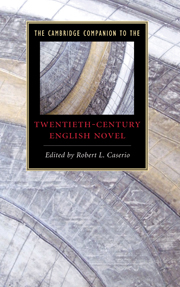Book contents
- Frontmatter
- Introduction
- 1 The art of English fiction in the twentieth century
- 2 The British Empire and the English modernist novel
- 3 Realism and rebellion in Edwardian and Georgian fiction
- 4 The Great War in English fiction
- 5 Postwar modernism in the 1920s and 1930s: The mammoth in the basement
- 6 Regionalism in English fiction between the wars
- 7 Ireland and English fiction
- 8 Feminist fiction
- 9 Working-class fiction across the century
- 10 World War II, the welfare state, and postwar “humanism”
- 11 The Windrush generation
- 12 History in fiction
- 13 Postmodernisms of English fiction
- 14 Detectives and spies
- 15 The post-consensus novel: Minority culture, multiculturalism, and transnational comparison
- 16 An absurd century: Varieties of satire
- 17 The other side of history: Fantasy, romance, horror, and science fiction
- Further reading
- Index
12 - History in fiction
Published online by Cambridge University Press: 28 July 2009
- Frontmatter
- Introduction
- 1 The art of English fiction in the twentieth century
- 2 The British Empire and the English modernist novel
- 3 Realism and rebellion in Edwardian and Georgian fiction
- 4 The Great War in English fiction
- 5 Postwar modernism in the 1920s and 1930s: The mammoth in the basement
- 6 Regionalism in English fiction between the wars
- 7 Ireland and English fiction
- 8 Feminist fiction
- 9 Working-class fiction across the century
- 10 World War II, the welfare state, and postwar “humanism”
- 11 The Windrush generation
- 12 History in fiction
- 13 Postmodernisms of English fiction
- 14 Detectives and spies
- 15 The post-consensus novel: Minority culture, multiculturalism, and transnational comparison
- 16 An absurd century: Varieties of satire
- 17 The other side of history: Fantasy, romance, horror, and science fiction
- Further reading
- Index
Summary
The protagonist of Anthony Burgess's A Malayan Trilogy (1957-9) nastily formulates a relation between history and books. “'History,' said Crabbe . . .'The best thing to do is to put all that in books and forget about it. A book is a kind of lavatory. We've got to throw up the past, otherwise we can't live in the present. The past has got to be killed.'” As soon as Crabbe makes his declaration, however, the narrator adds that “he reverted to his own past, and pronounced the very word in the Northern style . . . of his childhood” - a style that makes past sound like pest. Pestilent or not, emetically or not, history has been put into the twentieth-century English novel with a vengeance. It has occurred in a persistent idiosyncratic form: historical fiction by a single author about characters whose stories proliferate in multiple volumes. Burgess's trilogy is a mere mini-example of what might be called historical “series novels.” Tetralogies and five- or six-unit sequences abound; some stretch to a dozen and more.
Does so much reference to the past make living in the present easier? Some novelists write about the present as a product of the past or as itself epochal. Does seeing the present as historical also have vivifying effects? Or is it just a matter of profits for writers and publishers whose readers can be captivated by characters with whom, repeatedly, they “live”? Whatever the immediate material determination of the series form, historical crises suggest a motive. A culture undergoing actual transformation from an empire into an island might want to absorb the shock by reading about it, perhaps endlessly. The American title of Burgess's trilogy is The Long Day Wanes, a reference to the setting sun of Empire. As if in compensation, as the day wanes, the fiction waxes.
- Type
- Chapter
- Information
- The Cambridge Companion to the Twentieth-Century English Novel , pp. 176 - 191Publisher: Cambridge University PressPrint publication year: 2009

